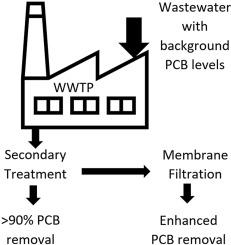Chemosphere ( IF 8.1 ) Pub Date : 2021-09-22 , DOI: 10.1016/j.chemosphere.2021.132335 Lisa A Rodenburg 1 , Michael R Hermanson 2 , Amy L Sumner 2

|
The Spokane River is impacted by levels of polychlorinated biphenyls (PCBs) that have triggered fish consumption advisories and exceed water quality standards. Select wastewater treatment plants (WWTPs) on the river have been upgraded from secondary (biological) treatment to tertiary treatment in the form of membrane filtration to address phosphorus contamination. Because membrane filtration is effective at removing particles, it is likely to reduce PCB concentrations in the effluent as well. In this work, PCBs measured in the influents and effluent of several WWTPs discharging to the river were examined. Implementation of membrane filtration reduced PCB concentrations in the effluent (and therefore PCB loads to the river) by 33% at a facility that produces recycled and virgin paper and by ∼55% at municipal WWTPs, compared to secondary (activated sludge) treatment. Largest reductions in concentrations in effluent and loads were achieved for higher molecular weight (MW) PCB congeners (i.e. those with six or more chlorines), homologs, and formulations. The more modest reductions in effluent concentrations achieved at the paper WWTP may be due to the mix of PCBs in the wastewater there: it contained primarily the low MW Aroclor 1242 (presumably from carbonless copy paper) and PCB 11 (3,3′-dichlorobiphenyl) possibly from pigments. PCBs that appear to be associated with silicone products such as caulk, tubing, and o-rings are relatively more abundant in the effluent of some plants compared to the influent, suggesting that these congeners arise from contamination during sampling or from within the plant itself. At some WWTPs, this contamination accounts for nearly a third of PCBs measured in the effluent.
中文翻译:

膜过滤对废水处理中多氯联苯去向的影响
斯波坎河受到多氯联苯 (PCB) 水平的影响,多氯联苯 (PCB) 已引发鱼类消费建议并超出水质标准。河流上的部分污水处理厂 (WWTP) 已从二级(生物)处理升级为以膜过滤形式进行的三级处理,以解决磷污染问题。由于膜过滤可有效去除颗粒,因此也可能降低流出物中的 PCB 浓度。在这项工作中,检测了几个排入河流的污水处理厂的进水和出水中的多氯联苯。膜过滤的实施在生产再生纸和原生纸的设施中将废水中的 PCB 浓度(以及因此向河流中的 PCB 负荷)降低了 33%,在市政污水处理厂降低了约 55%,与二级(活性污泥)处理相比。较高分子量 (MW) 的 PCB 同系物(即含有六种或更多氯的那些)、同系物和配方实现了流出物和负载浓度的最大降低。造纸 WWTP 的出水浓度降低幅度较小可能是由于废水中混合了多氯联苯:它主要包含低分子量 Aroclor 1242(大概来自无碳复写纸)和 PCB 11(3,3'-二氯联苯) 可能来自颜料。与流入物相比,似乎与硅酮产品(如填缝剂、管道和 O 形圈)相关的 PCB 在某些工厂的流出物中相对更丰富,这表明这些同系物来自采样过程中的污染或来自工厂本身。在一些污水处理厂,











































 京公网安备 11010802027423号
京公网安备 11010802027423号